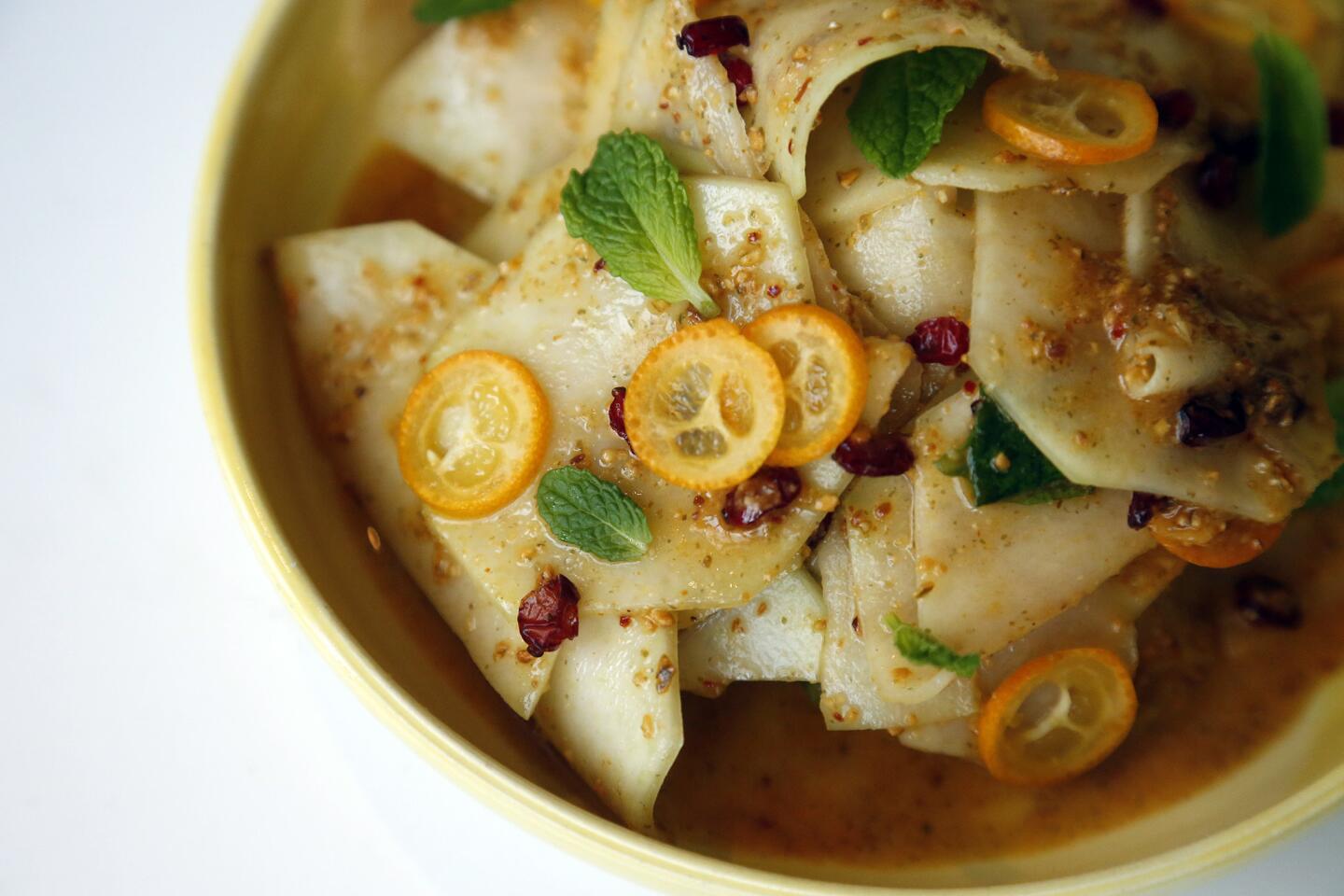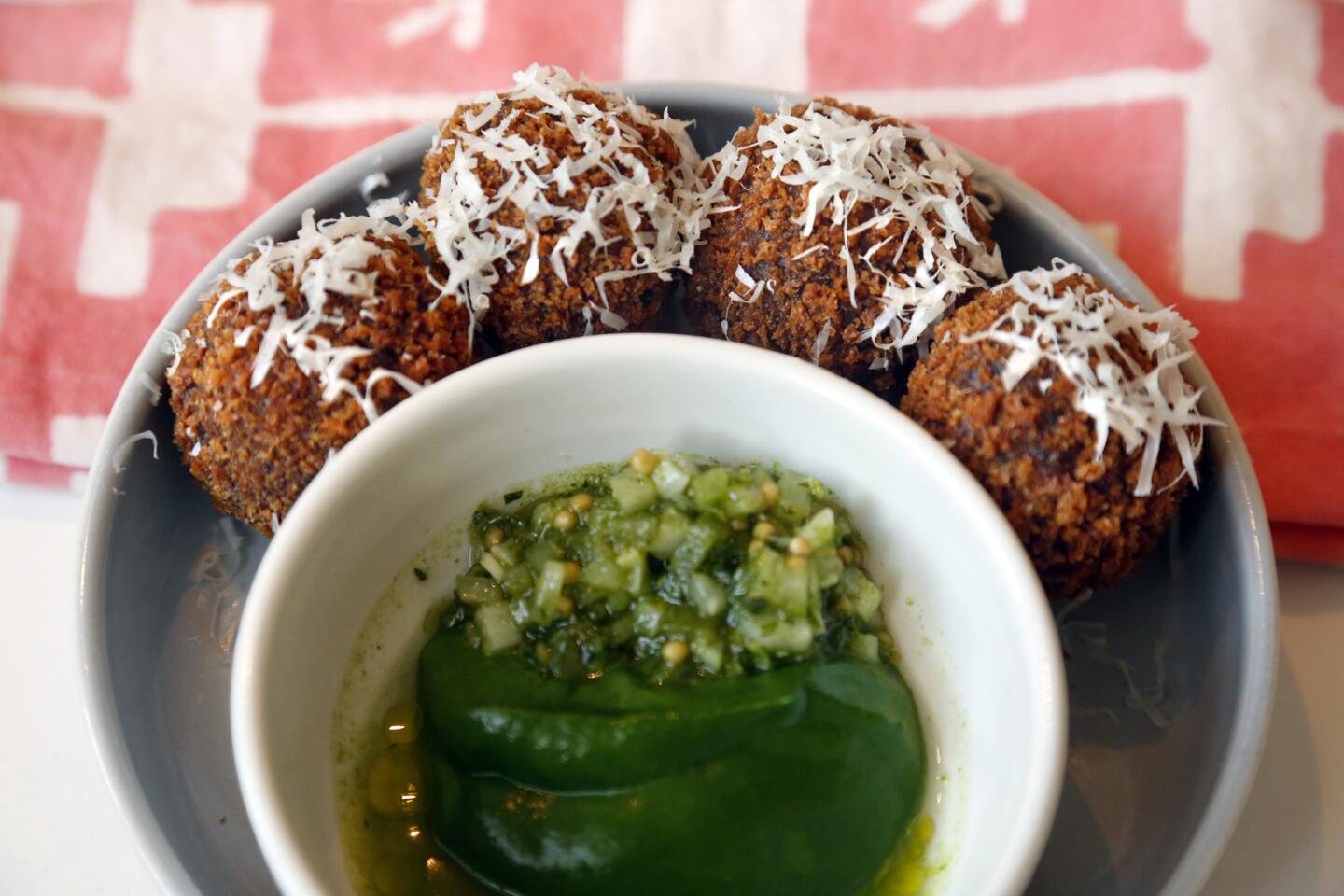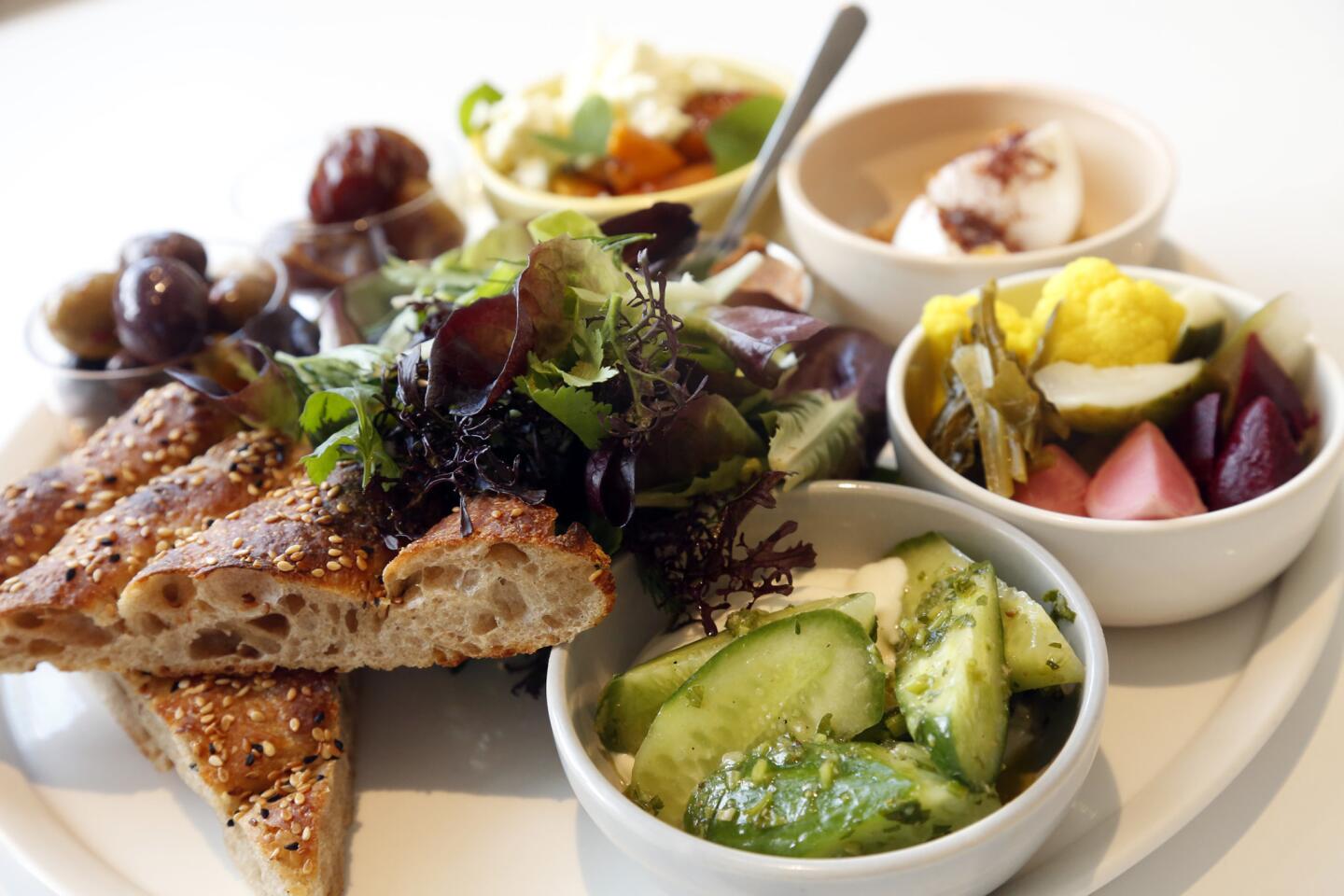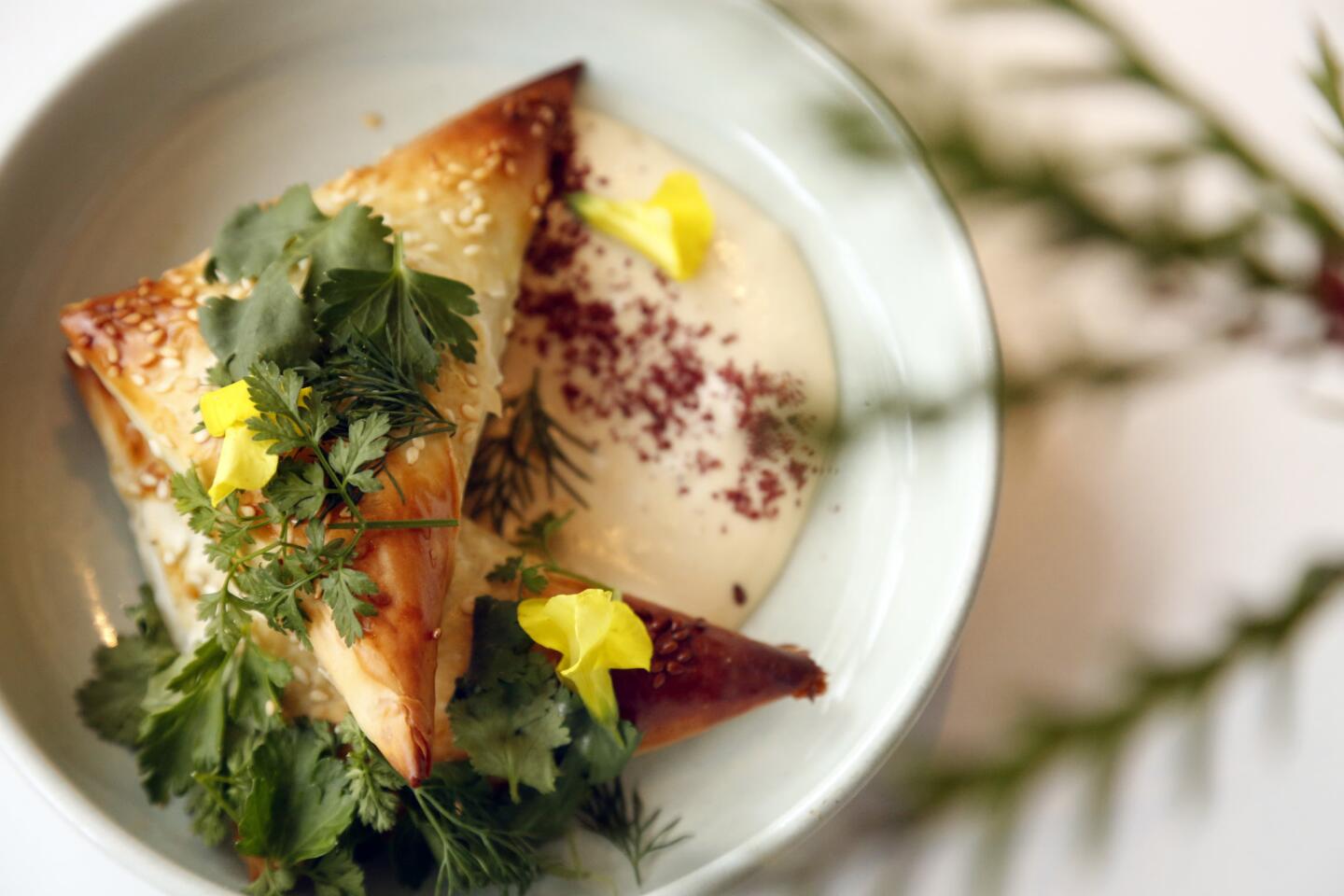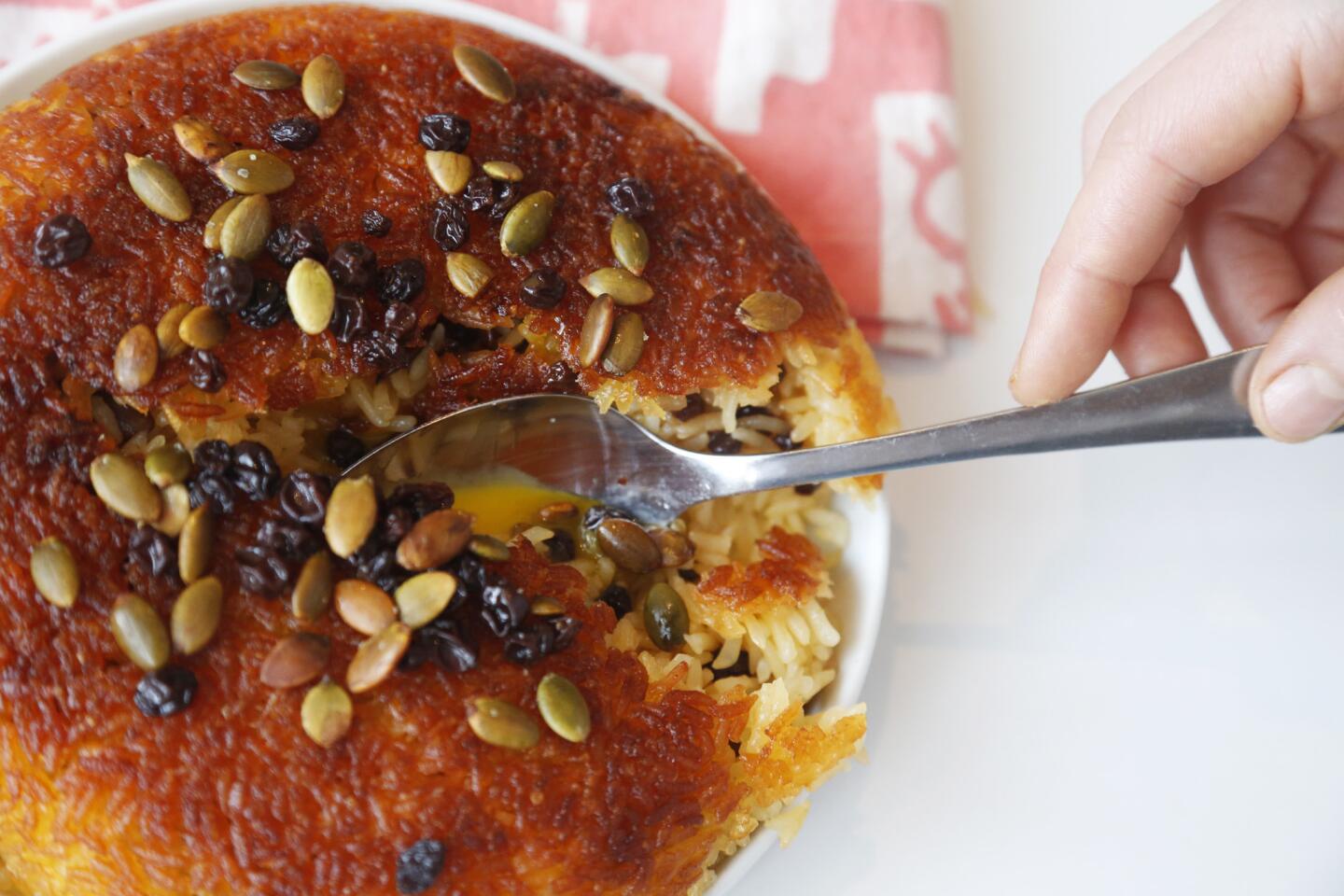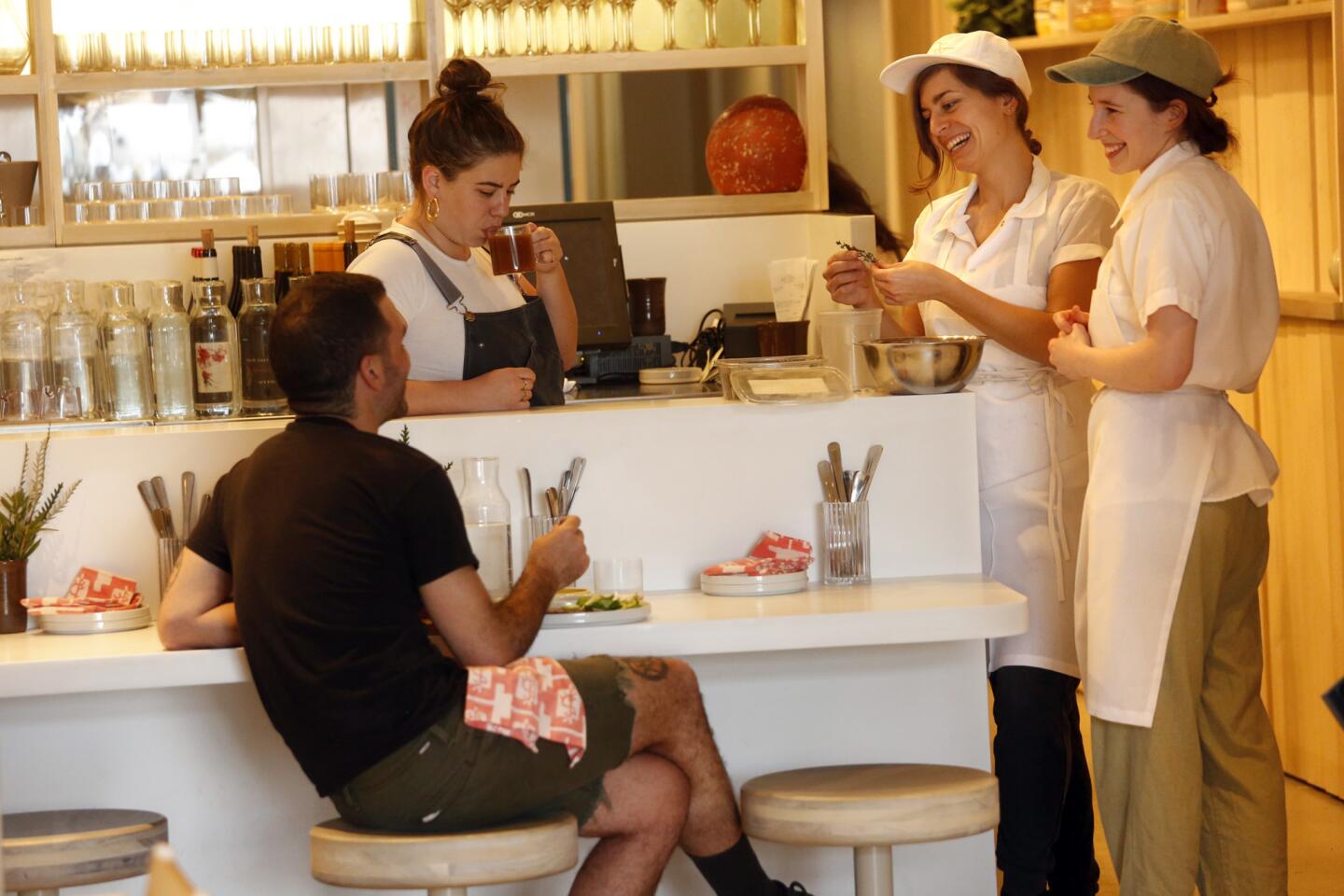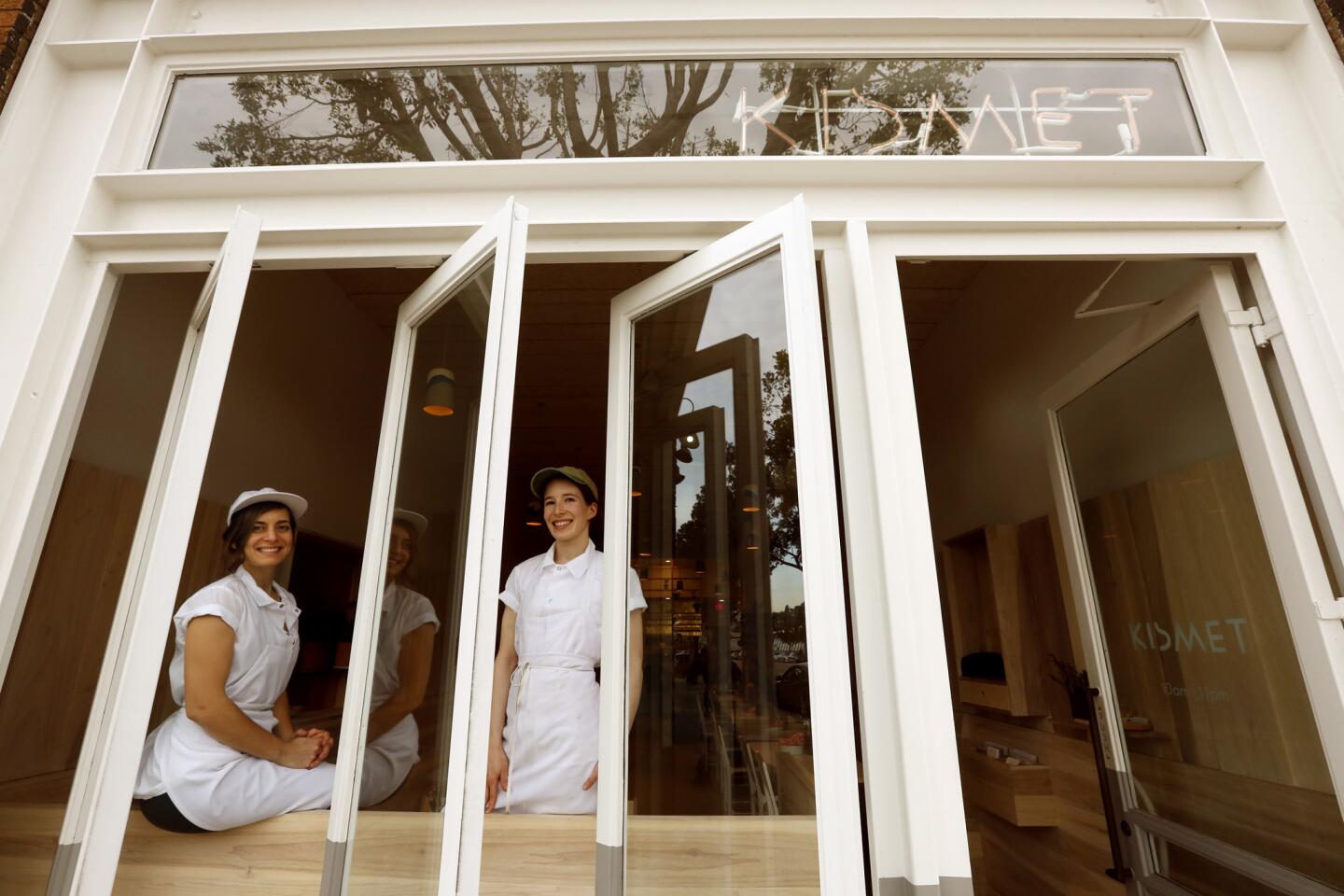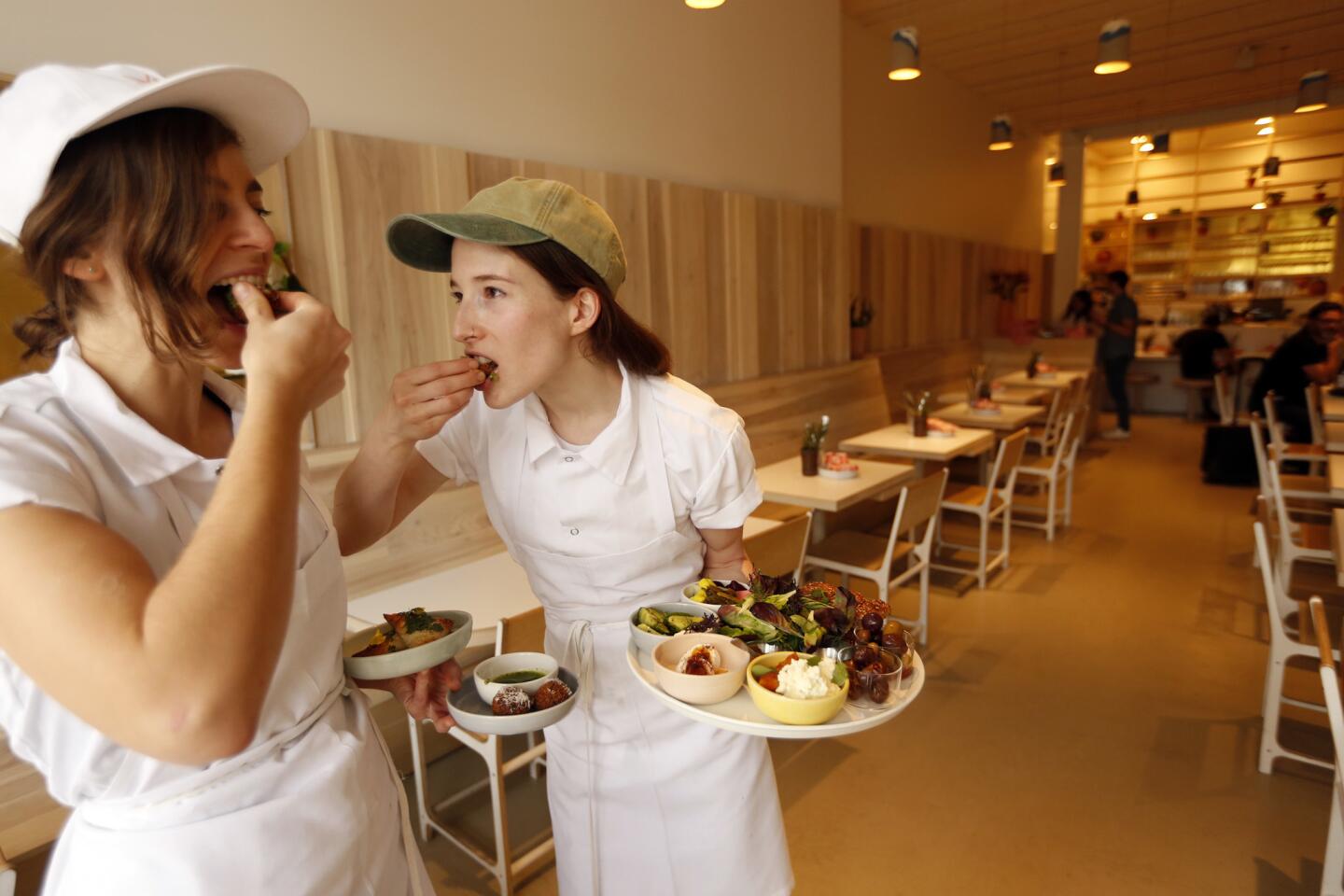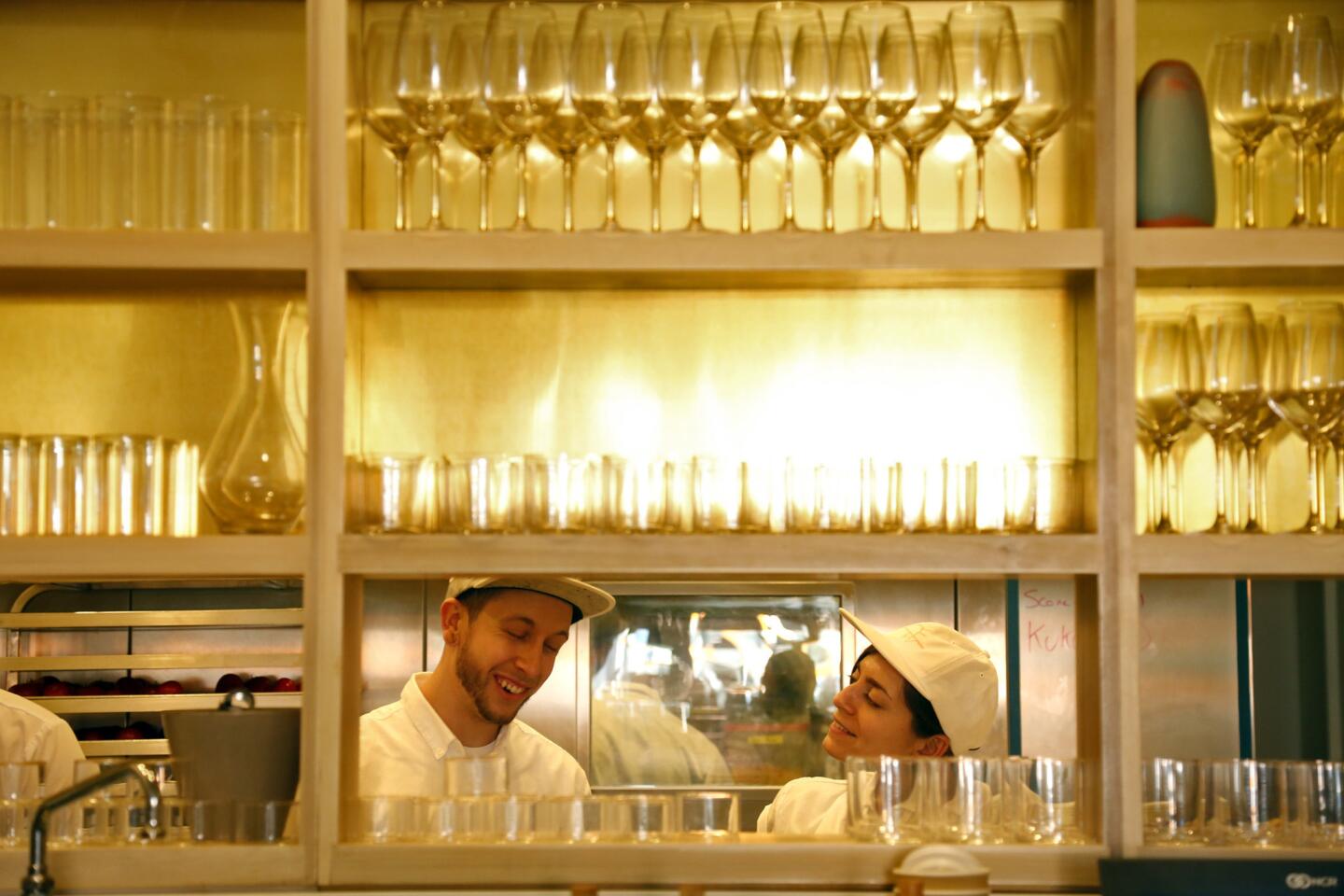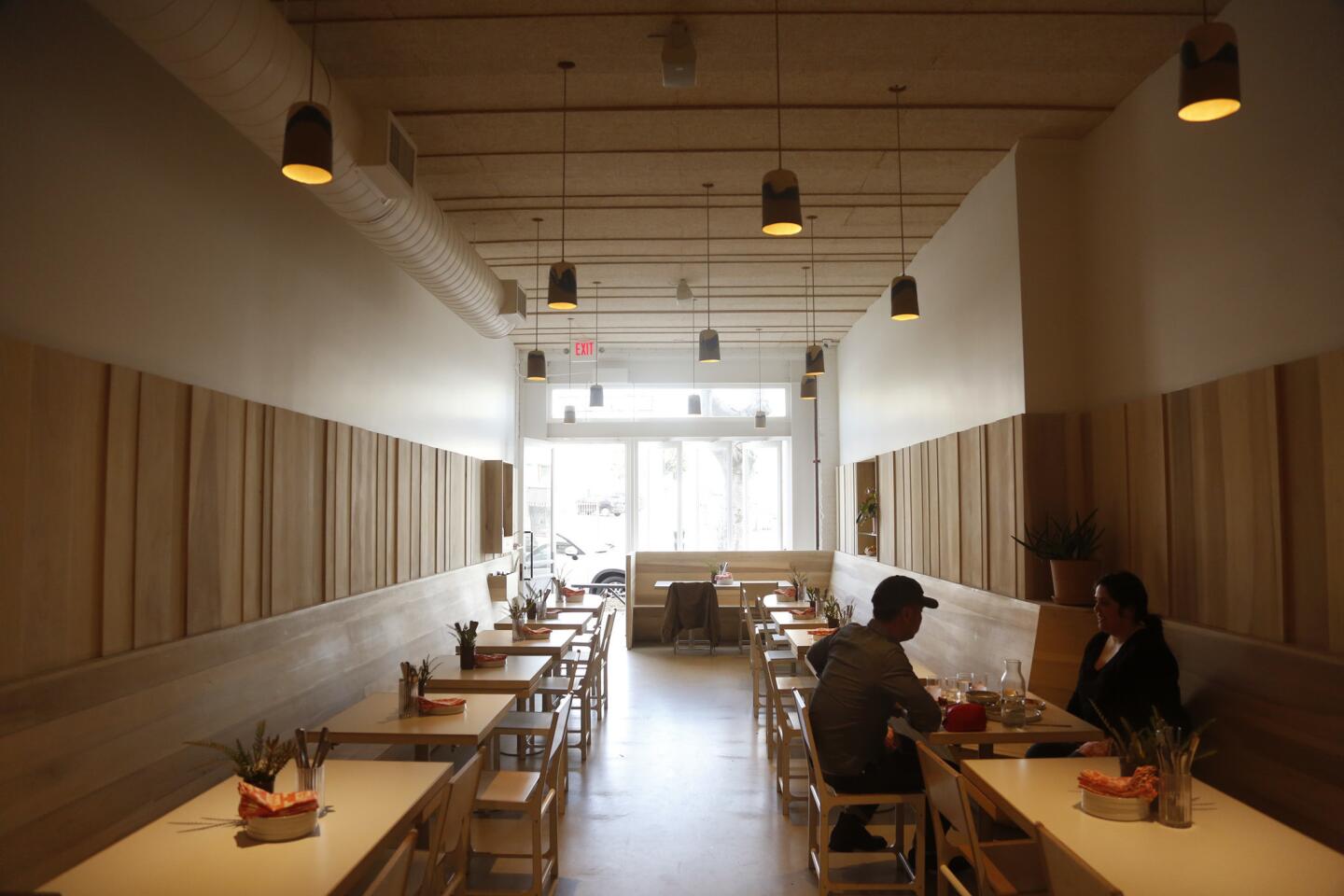Review: At Kismet, your culinary destiny may come in the form of rabbit kebabs
- Share via
I once spent a week tailing the band Hanson, three teenage boys who had grown up on an island where the only pop available to them was from Time Life rock ’n’ roll anthologies, 1957-69. And the music they made reflected it — their songs were the products of people who had thought deeply about Bobby Darin but had never heard Led Zeppelin or LL Cool J. And sometimes I think about Hanson when I’m sitting down to dinner at Kismet, the new quasi-Middle Eastern restaurant on Los Feliz’s southern edge.
It’s not because the sleek dining room is old-fashioned — the plant-filled Midcentury Modern groove could not be more present-day Los Angeles — or because its customers, who all look like recent Wesleyan grads, are anything less than yoga-toned and chic. The menu, surpassingly light and vegetable-intensive, has the carefully layered flavors, the touches of heat, tartness and herbal intensity that we have grown to expect from the best new kitchens. The aesthetic of co-chefs Sara Kramer and Sarah Hymanson, whom you may know from Madcapra in Grand Central Market if not from their former restaurant Glasserie out by Brooklyn’s Pulaski Bridge, is up-to-date: the tahini is made with sunflower seeds, the dining room smells of za’atar, and Aleppo pepper flows like water.
But the sensibility of their cooking, if you look at it a certain way, could be that of chefs whose vocabulary comes straight from the cookbooks of Alice Waters and Claudia Roden, expressing both the landscape of California and the lingering flavors of the Levant, directed by the snap of local vegetables and the ancient tang of ferment, with bits of animal coming in at the edges, if at all.
You could probably work your way through half an order of lamb belly before you realize that the point of the dish may lie less in the lemony mass of turnips and grain than in the chunks of fat, braised meat. You may be well into a plate of potatoes with crumbled macadamia nuts and housemade labneh before you discover that the unusual pungency you had been trying to puzzle out was not from an herb but from a scrap of fermented scallop. The triangle of pastry wrapped around a mince of chicken is not quite Moroccan b’stilla, not quite Turkish borek and definitely not an empanada, but it as delicious as any of them, its crunch faintly rhyming with a subtler crunch of toasted pine nuts, with a hint of lemon fragrance around the edge. What looks like falafel balls are actually freekeh fritters; crisp, brown crust surrounding loose slurries of the stewed green wheat. There is probably a technically accurate term for the dipping sauce that comes with those fritters, a kind of tahini fortified with crunchy bits of fermented vegetables, but the menu calls it “pickley green sauce,” and that will do just fine.
If you come for breakfast, Kramer and Hymanson will serve you shakshuka, yes, but also sesame-spiked granola, toasted brioche spread with halvah, or what they call “all the things,” which is to say the crunchy flatbread they get from Smorgasburg star Bub and Grandma’s, maybe some cucumbers with citrus, tiny potatoes with fennel, chunks of white cheese with kale, and containers of tahini and the thick, drained yogurt called labneh, which is especially good. You are going to want a round of the “flaky bread,” a dense, oily disk that may be closer to a Chinese pancake than to anything you might encounter in Anaheim’s Little Arabia, which is especially good with labneh and a bit of lemon zest.
I could probably survive for a week eating nothing but the stewed lamb with stripes of burnt cabbage and a cushion of bland, soothing freekeh porridge
Lunch is pretty much the same — those lemony chicken pies, the bright-green herbed frittata called kuku, and grilled bread topped with spicy, herb-laced broccoli braised into soft submission. The rosewater lemonade is oddly refreshing. I could probably survive for a week eating nothing but the stewed lamb with stripes of burnt cabbage and a cushion of bland, soothing freekeh porridge, like a Sunday dish they never quite got around to inventing somewhere in northern Syria.
Silver Lakers and Echo Parkistas may not be not quite so laggard as certain East Coast publications would have you believe, but Kismet’s all-day hours are appreciated in the neighborhood — sometimes you really need a za’atar squash tart and a glass of drip coffee at 3:30 in the afternoon.
And at dinner, the menu may less change than plump out. A snacky salad of shaved kohlrabi reveals itself as a slippery, glamorous composition slashed with the sour smack of kumquats and the dried Iranian fruit barberry. You dip tiny halved turnips into sweet butter glazed with salty-tart preserved lemon and chase them with a draught of fizzy natural wine. There is a bowl of pickled mussels, picked free of their shells, floating in a murky liquid with sweet currants; borlotti beans zapped with a funky mince of fermented turnip tops; and a dish of sliced hen of the woods mushrooms, edges frilly and crisp, sharing space with what appears to be a well-spiced chickpea tagine.
If you have a little money in your pockets, you might try the huge rabbit platter: rabbit stew, roasted legs scattered with herbs, and cubes of rabbit meat grilled like kebabs with caramelized squash. It feeds two — maybe as many as four, if you happen to be wearing skinny jeans. It was Kramer and Hymanson’s famous dish in their restaurant in Brooklyn, and I had been waiting more than a year to try it in Los Angeles. I suspect you will not be disappointed.
::
Kismet
The chefs behind the Grand Central Market falafel stall Madcapra open a Middle Eastern restaurant
LOCATION
4648 Hollywood Blvd., Los Angeles, (323) 409-0404, www.kismetlosangeles.com.
PRICES
Snacks $6-$12; salads $13-$15; “dishes’’ $16-$26; rabbit $80.
DETAILS
Open 10 a.m. to 11 p.m. daily. Credit cards accepted. Beer and wine. Street parking. Twenty percent service charge automatically added to bill.
RECOMMENDED DISHES
Tokyo turnips; chicken and pine nut pies; kohlrabi with pumpkin seeds; jeweled crispy rice; cranberry beans; rabbit.
MORE FROM JONATHAN GOLD
Jonathan Gold reviews Irenia in Santa Ana, which is reinterpreting traditional Filipino cuisine
At 71Above, the view of L.A. is even prettier than the food
First Impression: China Taste, maybe the San Gabriel Valley’s first Anhui-style restaurant
